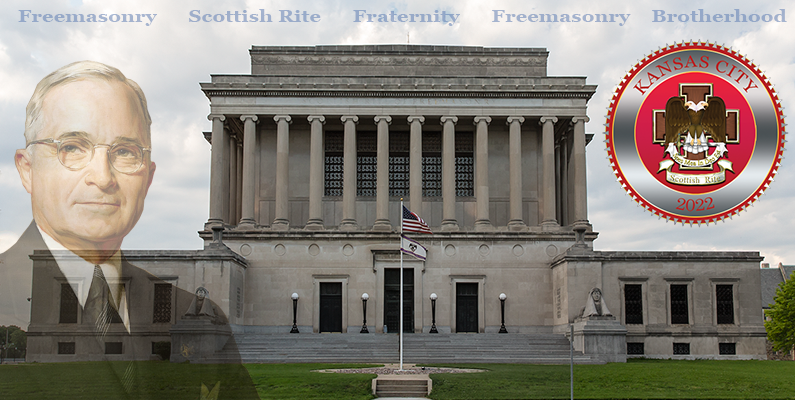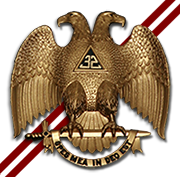
Scottish Rite History

Cerneauism In the late 1800s, the Supreme Councils for the Northern Masonic Jurisdiction (NMJ) and the Southern Jurisdiction (SJ) began using the wonderfully peculiar word "Cerneauism" to describe the "clandestine" Scottish Rite bodies that persisted after the Union of 1867 had merged two previously competing Supreme Councils in the northeast to form the present-day NMJ. Cerneauism referred to Joseph Cerneau (1763-1840/45) and to the fact that these bodies traced their organizational roots (sometimes aspirationally) back to organizations formed by Joseph Cerneau in the early nineteenth century.
Cerneauism & Anti-masonry:
Two Plaques of 19th-Century Masonry
By Arturo de Hoyos, 33°, G.C., and Brent Morris, 33°, G.C.
Cerneauism
The Mother Supreme Council was created in Charleston, South Carolina, in 1801 to bring order to the chaotic world of high degree Masonry, but its early effects were just the opposite. The Constitutions of 1786 authorized two Supreme Councils in the United States, and the Charleston body seemed intent on waiting until just the right moment to divide its territory and share it with a sister Supreme Council. The right moment came sooner than expected.
Opportunists in New York In August 1806, Antoine Bideaud, a member of the Supreme Council of the “French West India Islands,” visited New York City and found an opportunity to make a little extra money. He conferred the Scottish Rite degrees on J. J. J. Gourgas and four other Frenchmen for $46 each and then created a “Sublime Grand Consistory 30°; 31°; and 32°.” Bideaud’s authority was for the islands only and certainly did not extend into New York, which was then under the jurisdiction of the Charleston Supreme Council. Principal officers of the Bideaud Supreme Council were J. J. J. Gourgas, Daniel D. Tompkins, Sampson Simson, and Richard Riker.
In New York City in October 1807, Joseph Cerneau, a jeweler from Cuba, constituted a “Sovereign Grand Consistory of Sublime Princes of the Royal Secret.” Cerneau was a “Deputy Grand Inspector, for the Northern part of the Island of Cuba” under the Order of the Royal Secret. His patent limited him to confer the 4° through 24° on Lodge officers, and the 25° once a year. Early records are sufficiently vague that it cannot be determined if the original members of Cerneau’s Sovereign Grand Consistory thought they had the 25° or the 32°. With even less authority than Bideaud, Cerneau launched his foray into high-degree Masonry in New York. Primary officers of the Cerneau Grand Consistory included Cerneau, De Witt Clinton, John W. Mulligan, and Cadwallader D. Colden.
Complicating the situation of the rival and equally illegitimate consistories were the personal, political, and Masonic rivalries of their principal officers. Tompkins as governor of New York was succeeded by Clinton, his lieutenant governor; Clinton as Grand Master of New York was followed by Tompkins. Simson and Mulligan opposed each other in Grand Lodge; Mulligan defeated Simson as Grand Treasurer in 1814, but Simson regained the office in 1815. Colden was assistant attorney general in 1798 and replaced Riker as district attorney in 1811; Riker regained the position in 1812.
Neither Clinton nor Tompkins cared one whit for the honors conferred upon him by his Supreme Council. Both of them were first, last and always, politicians, bending every effort and every agency they could to secure for themselves political preferment.… [Each was] perfectly willing to permit Freemasonry to use itself in his service.… Mulligan and Simson were adversaries in the Grand Lodge of New York. The professional paths of Colden and Riker were continually crossing and soon we find their political reactions antagonistic.
Legitimacy in the North
In 1813 Emmanuel de la Motta, Grand Treasurer of the Mother Supreme Council, traveled to New York City for his health. While there he discovered the two competing “Supreme Councils,” each created without authorization from Charleston. He examined the two groups and “healed” the Bideaud organization, making it legitimate. His actions were confirmed by the Mother Supreme Council on December 24, 1813, which issued letters of Constitution for the Bideaud Supreme Council on January 7, 1815.
The Cerneau Grand Consistory ignored de la Motta’s actions, but it was aware the competition had thirty-two degrees.
To the minds of Clinton and his colleagues something had to be done to put their Grand Consistory at least on the same level as the Bideaud Sublime Grand Consistory, and they wheedled Joseph Cerneau into taking a step which in all probability he otherwise would not have taken.
In 1813 Cerneau claimed jurisdiction over thirty-two degrees [for his Sovereign Grand Consistory] and announced the formation of what he called a Supreme Council of Grand Inspectors General of the Thirty-third Degree for the United States of America.… In this body both Clinton and Colden were given high official posts.
The two Supreme Councils continued side-by-side for years, usually as bitter rivals, each having their ups and downs, though the Cerneau faction had the more irregular existence. Neither side was diplomatic in language, and each seemed to delight in bold, public condemnations of the other. Finally in 1867, after years of feuding, the two sides peacefully united to form the Supreme Council, 33°, for the Northern Masonic Jurisdiction of the United States. The peace was short-lived.
The Cerneau Supreme Council(s) Revived
Harry Seymour, expelled from the Cerneau Supreme Council in 1865, started the Ancient and Primitive Rite of Freemasonry, an outgrowth of the Rite of Memphis of about ninety degrees. By 1872 Seymour had reduced the rite to thirty-three degrees and was claiming to confer Scottish Rite degrees as the only legitimate successor to Joseph Cerneau. Robert Folger and others, angered by the position of the United Supreme Council towards the old Cerneau Supreme Council, revived the Cerneau Supreme Council in 1881. Both of these Supreme Councils proudly traced their origins to Joseph Cerneau, and about this time the term Cerneauism was coined to describe their movement.
Cerneauism finally died when the corrosive rivalry of the groups spilled over into the activities of other Masonic organizations. Grand lodges began asserting their authority as the ultimate arbiters of Masonic regularity within their jurisdictions. Masons in state after state were forbidden to join a Cerneau body under pain of expulsion. Several suits were brought by Cerneauists challenging the authority of grand lodges to declare them forbidden, but each case eventually was lost. The Cerneau movement ended in 1919 when M. W. Bayliss died. He was the head of Folger’s revived Cerneau Supreme Council and probably the last Cerneau officer.
The American Anti-masonic Movement
As Freemasonry grew in prestige and importance in America during the eighteenth and early nineteenth centuries, many citizens became increasingly concerned about its effect on the republic. Some disliked private meetings of wealthy and important men in lodges. Others objected to Masonic toasting, drinking, and singing after meetings, while still others found the Masonic ideal of religious tolerance blasphemous, especially when applied to non-Christians. In short, the growing respectability of Masonry was matched by the increasing suspicions of anti-Masons.
The Abduction of William Morgan
In 1826 in Batavia, New York, William Morgan, a disgruntled Mason, announced plans to publish the rituals of Freemasonry. This created a great deal of excitement in the community— Masons were outraged their “secrets” would be divulged and citizens were eager to know what the Masons were hiding. Neither group seemed to be aware that nearly thirty Masonic exposes had been published in English since 1723. A fire in Morgan’s printer’s office was blamed on the Masons, while the Masons blamed the printer for staging a publicity stunt. On September 11, Morgan was arrested for a debt and was jailed in Canandaigua, New York. The next day four Masons appeared at the jail, discharged the debt, and escorted Morgan to an awaiting carriage. He was driven to Ft. Niagara, held in the old Powder Magazine for five days, and never seen after September 19, 1826.
The public was shocked by the charges that Morgan had been murdered by the Masons. “In February, April, and August of 1827, various participants in Morgan’s abduction were tried; but the choice of Masonic jurors, the silence of the local press, and the circumspection of law enforcement officers who were also Masons outraged some people. The sentences were light, ranging from a few months to two years.”
The Birth of a Movement
Fueled by the outrage of Morgan’s abduction and by a general sense of helplessness in the face of huge social changes of the time, many people found Masonry convenient to blame for all of society’s ills.
The Antimasons quickly developed a conspiracy theory with respect to Masonry, “suddenly” uncovering a group of unscrupulous leaders plotting to overthrow the American social order.… Many Antimasons believed that Masonic secrecy concealed the members’ “unconditional loyalty” to an autonomous state, and this allegiance far exceeded any loyalty to the nation.
In the decade after William Morgan’s disappearance, Antimasonry raged like a brushfire, spreading into politics and giving birth to the first third party in American history. It expanded from western New York in an arc that stretched from Pennsylvania to Maine. The flames of Antimasonry burned especially brightly in New England. In Vermont, Antimasons became the largest political party in the early 1830s; in Massachusetts they edged aside the Democrats to become the second strongest party; in Rhode Island they captured the balance of power between Democrats and National Republicans and ruled in coalition with the Jacksonians. In Connecticut they polled at their peak almost a quarter of the vote.
The high water mark of political anti-Masonry came in the 1832 presidential election when William Wirt ran on the Anti-Masonic ticket against two Masons, Andrew Jackson and Henry Clay. The political movement soon died after Wirt’s defeat, but the effects of social anti-Masonry lingered much longer.
Many churches banned Masons and argued that unless it was destroyed, Masonry as a tool of Satan would overthrow the church and its moral code along with the American system of justice and other republican institutions. Anti-Masons, using the religious argument, therefore condemned Masonry as an evil and dealt with it as they would with any other form of “flagrant Sin.”
New York went from 480 Lodges in 1826 to 75 in 1835; Massachusetts dropped from 108 Lodges in 1830 to 56 Lodges in 1840. The Grand Lodge of Vermont simply went out of existence. The anti-Masonic movement was strongest in the Northeast, but its effects were felt throughout all the United States. The low point for Masonry came in 1840, after which the fraternity slowly regained members and prominence. It was not until 1860 that American Freemasonry fully recovered from the Morgan Affair.

